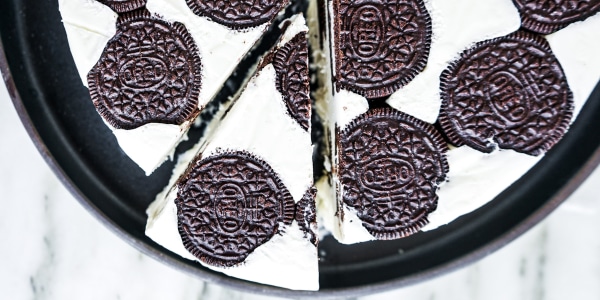Television personality Elena Besser is joining TODAY to answer kitchen questions submitted by our viewers. She sets the record straight on everything from how to properly use kitchen appliances to the best ways to heat up leftovers and everything in between. Plus, she's sharing her recipe for an easy, no-bake cookies and cream ice box cake.
What are the different settings on an oven? When are you supposed to use broil vs. bake?
In general, an oven circulates heat and cooks things from the outside in. So, the higher the temperature, the faster the exterior will cook. The lower the temperature, the more consistently the temperature will permeate through the food itself.
- Baking: Cooking at a consistent medium heat (375 F or lower) to cook things evenly from the outside in (like cakes, pies, etc.).
- Roasting: Cooking in the oven at a higher temperature, so anything between 400 F and above. Think crispy potatoes.
- Broiling: Only uses the top heat element of an oven. Think of broiling like a toaster oven; it is great for melting cheese, browning the tops of foods or toasting bread. I actually use my broiler as my toaster and don't own a toaster at all!
When should you use the microwave over the oven?
Use the microwave if you want to quickly prepare food or multitask in the kitchen. The microwave sends energy waves to heat the tiny particles inside of food. So, just like the sun heats your face, the microwave heats your food.
- Baked potato: If you bake a potato in the microwave, it takes about 12 to 15 minutes to cook, while an oven takes up to an hour.
- Eggs: Quickly cook eggs in a mug, a great recipe to teach your kids how to make breakfast for themselves.
What's the best way to heat up leftovers?
Whenever I think about leftovers, I always think about how I can make them taste as close to the way they tasted when I first made them. Therefore, I think that the best way to reheat food is to reheat it the same way that it was first cooked.
For example, if it is pizza, I love to heat it up directly on the rack of the oven with a foil-lined sheet tray on the rack below. This will warm the pizza up from the top and bottom, resulting in a crispy crust and gooey cheese (plus, the sheet tray will catch any bits that may fall to the bottom).
- Oven: For bread, pastries, proteins, warm sandwiches and pizza. Always for fried food. Place it into the oven at a super high temperature to crisp the exterior of the food and revive it.
- Microwave: For stir-fries, steamed foods, stews or soups, rice, pasta and noodles. I always make sure that I put a damp towel over the top of the food to make sure it doesn't dry out and doesn't pop in your microwave and make a massive mess.
- Stovetop: This is a happy medium between the two. You can reheat soups, stews, rice, pasta, stir fries and protein. If you're just heating up 1 to 2 slices of pizza or a cheese sandwich, the stovetop works too. It may take longer than the microwave though, so if you are in a hurry, use the microwave.
What are things you can freeze unexpectedly? How do you keep frozen foods fresh?
In general, the freezer should be your best friend. I love to pop extra food I have into the freezer to prevent it from going bad, like fresh fruits, protein, cookies and that banana bread I made a double batch of. The most important thing to remember is you don't want freezer burn! Here's how to keep food fresh in the freezer:
- Freezer burn is the difference between a delicious freezer meal and one that tastes off. So, to prevent weird discoloration and unpleasant textures, make sure that you are removing as much air as possible from the bag you store your food in. If you want to be fancy, buy a vacuum-sealer machine, or hack it: I use a straw to suck out any air to vacuum-seal the food.
- Although food can last for up to a year in the freezer, try to use it within three months of freezing for maximum freshness.
- If it is something larger like a loaf of bread, you can either wrap it tightly in plastic wrap, or cut the bread into smaller pieces, wrap the pieces tightly in plastic wrap, and then transfer into a freezer bag.
- Regardless of how you store the items, always make sure to label them with the date you stored them so you can keep track of their freshness.
Why do you prefer to buy frozen vegetables over fresh?
When I have the option of using frozen vegetables (like peas or spinach) or fruits (like strawberries or blueberries) versus fresh, I always opt for frozen. Frozen foods in the grocery store were picked at peak freshness and immediately frozen so they are likely to have the most flavor and nutritional value. I also always opt for frozen fish and seafood, too.


